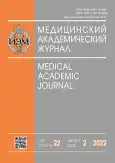Activation and modulation of Ire1-Xbp1 pathway in SARS-CoV-2 infected Vero cells (B.1.1.7 Alpha, B.1.617.2 Delta, B.1.1.529 Omicron variants)
- Authors: Shishova A.A.1,2, Baryshnikova V.S.1, Ermakova M.Y.1, Turchenko Y.V.1, Dereventsova A.V.1, Fominykh K.V.1
-
Affiliations:
- Chumakov Federal Scientific Center for Research and Development of Immune-and-Biological Products of Russian Academy of Sciences
- Sechenov First Moscow State Medical Univesity
- Issue: Vol 22, No 2 (2022)
- Pages: 269-276
- Section: Conference proceedings
- URL: https://journal-vniispk.ru/MAJ/article/view/108694
- DOI: https://doi.org/10.17816/MAJ108694
- ID: 108694
Cite item
Abstract
BACKGROUND: The emergence of new variants of the SARS-CoV-2 virus at the end of 2020, which became a source of increased risk for global public health, prompted the study of their molecular biological characteristics and pathogenic effects. It is known that one of the reasons for the viruses’ pathogenic action is their interaction with the defense mechanisms of the cell. Ire1 (inositol-requiring enzyme 1)-mediated splicing of Xbp1 mRNA (X-box binding protein 1) is a protective mechanism that is activated in response to the accumulation of misfolded proteins in the cell, a situation that occurs due to uncontrolled synthesis of viral proteins during infection. Studying the interaction of different variants of the SARS-CoV-2 virus with this protective mechanism will help to shed light on various aspects of the pathogenesis of a new coronavirus infection.
AIM: Study of Ire1-Xbp1 defense mechanism activation and modulation in SARS-CoV-2 infected Vero cells.
MATERIALS AND METHODS: We studied the activation of the Ire1 enzyme in Vero cells infected with various variants of the SARS-CoV-2 virus using immunoblotting and antibodies to various forms of this protein in the cell. In addition, we studied the activation of Xbp1 mRNA splicing under conditions of infection with various variants of the SARS-CoV-2 virus in a PCR reaction with specific primers.
RESULTS: Reproduction of B.1.1.529 (Omicron) strain in Vero cells is slower than B.1.1.7 (Alpha) and B.1.617.2 (Delta) strains of SARS-CoV-2. The whole reproduction cycle is 48 hours.
Ire1-dependent defense mechanism is activated after 12 hours of SARS-CoV-2 infection with either of three variants. However, despite the activation of the Ire1 endonuclease domain, there is no Xbp1 mRNA splicing in SARS-CoV-2 infected cells. Inhibition of Xbp1 mRNA splicing occurs slower in Vero cells infected with the B.1.1.529 — Omicron variant.
CONCLUSIONS: The paper describes the reproduction of various variants of the SARS-CoV-2 virus in Vero cell culture and the activation of the Ire1-Xbp1 defense mechanism during infection. The Ire1 endonuclease is phosphorylated, however, mRNA splicing of the Xbp1 transcription factor is impaired in SARS-CoV-2 infected cells. A decrease in the rate of inhibition of this protective mechanism in Vero cells infected with the Omicron (B.1.1.529) variant of the SARS-CoV-2 virus may be the reason for its lower pathogenicity described in various studies.
Keywords
Full Text
##article.viewOnOriginalSite##About the authors
Anna A. Shishova
Chumakov Federal Scientific Center for Research and Development of Immune-and-Biological Products of Russian Academy of Sciences; Sechenov First Moscow State Medical Univesity
Author for correspondence.
Email: shishova_aa@chumakovs.su
ORCID iD: 0000-0002-5907-0615
Research Associate, Laboratory of Biochemistry; Senior Lecturer of the Department of Organization of Technologies for the Production of Immunobiological Research
Russian Federation, Moscow; MoscowVictoria S. Baryshnikova
Chumakov Federal Scientific Center for Research and Development of Immune-and-Biological Products of Russian Academy of Sciences
Email: baryshnikova_vs@chumakovs.su
ORCID iD: 0000-0002-4128-3989
Junior Research Associate, Laboratory of Biochemistry
Russian Federation, MoscowMaya Yu. Ermakova
Chumakov Federal Scientific Center for Research and Development of Immune-and-Biological Products of Russian Academy of Sciences
Email: ermakova_mj@chumakovs.su
ORCID iD: 0000-0002-8229-7818
Microbiologist of Analytical Method Development and Validation Team
Russian Federation, MoscowYuriy V. Turchenko
Chumakov Federal Scientific Center for Research and Development of Immune-and-Biological Products of Russian Academy of Sciences
Email: turchenko_jv@chumakovs.su
ORCID iD: 0000-0003-0869-0045
Junior Research Associate, Laboratory of Biochemistry
Russian Federation, MoscowAlena V. Dereventsova
Chumakov Federal Scientific Center for Research and Development of Immune-and-Biological Products of Russian Academy of Sciences
Email: dereventsova_av@chumakovs.su
ORCID iD: 0000-0002-9612-2146
Junior Research Associate, Laboratory of Biochemistry
Russian Federation, MoscowKseniya V. Fominykh
Chumakov Federal Scientific Center for Research and Development of Immune-and-Biological Products of Russian Academy of Sciences
Email: foxenia@gmail.com
ORCID iD: 0000-0003-0788-514X
Research Associate, Laboratory of Biochemistry
Russian Federation, MoscowReferences
- Xue M, Feng L. The Role of unfolded protein response in coronavirus infection and its implications for drug design. Front Microbiol. 2021;12:808593. doi: 10.3389/fmicb.2021.808593
- Walter P, Ron D. The unfolded protein response: from stress pathway to homeostatic regulation. Science. 2021;334(6059):1081–1086. doi: 10.1126/science.1209038
- Chen Y, Brandizzi F. IRE1: ER stress sensor and cell fate executor. Trends Cell Biol. 2013;23(11):547–555. doi: 10.1016/j.tcb.2013.06.005
- Ali MM, Bagratuni T, Davenport EL, et al. Structure of the Ire1 autophosphorylation complex and implications for the unfolded protein response. EMBO J. 2011;30(5):894–905. doi: 10.1038/emboj.2011.18
- Korennykh AV, Egea PF, Korostelev AA, et al. The unfolded protein response signals through high-order assembly of Ire1. Nature. 2008;457(7230):687–693. doi: 10.1038/nature07661
- Back SH, Lee K, Vink E, Kaufman RJ. Cytoplasmic IRE1alpha-mediated XBP1 mRNA splicing in the absence of nuclear processing and endoplasmic reticulum stress. J Biol Chem. 2006;281(27):18691–18706. doi: 10.1074/jbc.m602030200
- Calfon M, Zeng H, Urano F, et al. IRE1 couples endoplasmic reticulum load to secretory capacity by processing the XBP-1 mRNA. Nature. 2002;415(6867):92–96. doi: 10.1038/415092a
- Lee A, Iwakoshi NN, Glimcher LH. XBP-1 Regulates a subset of endoplasmic reticulum resident chaperone genes in the unfolded protein response. Mol Cell Biol. 2003;23(21):7448–7459. doi: 10.1128/mcb.23.21.7448-7459.2003
- Jheng JR, Lin CY, Horng JT, Lau KS. Inhibition of enterovirus 71 entry by transcription factor XBP1. Biochem Biophys Res Commun. 2012;420(4):882–887. doi: 10.1016/j.bbrc.2012.03.094
- Zhang HM, Ye X, Su Y, et al. Coxsackievirus B3 infection activates the unfolded protein response and induces apoptosis through downregulation of p58IPK and activation of CHOP and SREBP1. J Virol. 2010;84(17):8446–8459. doi: 10.1128/JVI.01416-09
- McMahan K, Giffin V, Tostanoski LH, et al. Reduced pathogenicity of the SARS-CoV-2 omicron variant in hamsters. Med (NY). 2022;3(4):262–268.e4. doi: 10.1016/j.medj.2022.03.004
Supplementary files









